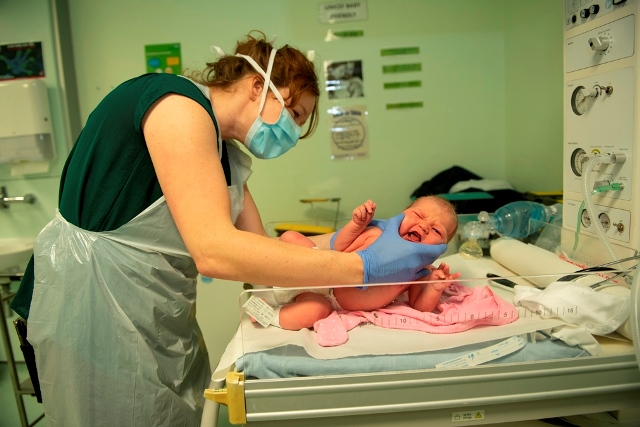
Meet baby Anastasia, photographed with midwife and Royal Free Hospital (RFH) labour ward co-ordinator Laura Halpin, at the end of April, not long after her birth.
This striking image has been entered by the Royal Free London (RFL) into the Hold Still photography competition, launched by the Duchess of Cambridge on behalf of the National Portrait Gallery. The competition asked people to submit a picture to document life in lockdown.
The RFH was one of the very first hospitals to admit patients with COVID-19 and has since treated hundreds of patients with the virus. Almost all of the hospital’s wards were re-purposed to care for COVID-19 patients - but the maternity ward remained open, although visitor access was significantly restricted. Birthing partners were only allowed in the hospital when the woman was actually in labour and had to leave immediately afterwards.
The RFL commissioned photographer Hannah Maule-Ffinch to take pictures from around the trust to showcase our incredible staff and patients during these unprecedented times and we will continue to share more of our images in the coming weeks and months.
Laura, 36, qualified as a midwife at the RFH, then worked abroad in Australia and New Zealand. She returned to the RFH as bank staff then worked at Newham Hospital before returning to the RFH three years ago to take up a full time post as labour ward co-ordinator.
When this picture was taken she was conducting the newborn infant physical examination (NIPE), which must take place within 72 hours of birth.
She said: “This is a top to toe test checking everything, for example if there is a heart murmur, if the baby’s retinas are intact, the position of the baby’s ears and eyes and if the hips show any sign of dysplasia. While I was carrying out the checks I was turning Anastasia over. Her face is clearly saying, ‘What are you doing!’.”
Laura says her decision to become a midwife was an instinctive one.
She said: “My sister had my nephew when I was 18 and I was her birthing partner. My aunt had a baby when I was 10 and my mum said I was completely fascinated with the pregnancy and how the body works.”
Laura has worked as a midwife for over 10 years and been present at hundreds of births but says COVID-19 forced her and her colleagues to adopt very different working practices at speed.
She said: “For instance during the NIPE examination I would always have worn gloves but previously I wouldn’t have had to wear the mask. Full PPE – including visors and an FP3 mask – is currently worn when women are giving birth and it does make it harder for us to develop a relationship with the women as you rely so much on communicating with your face. It feels very clinical.
“The PPE is also incredibly hot. Prior to COVID-19 a midwife could have briefly left the room for a quick drink of water after helping the woman push and deliver before coming back to finish things up but now we have to remain because it is too time consuming to take it off and put it all back on again for a short break.”
Laura is incredibly proud of how the team have adapted and stepped up to the challenge: “The team have been completely brilliant. From day one they just got on with it and accepted the myriad changes that kept coming at us from morning to night. Birth is unpredictable but these times have been something else. I love this image, I think it shows the empathy behind the mask.”
 Translate
Translate